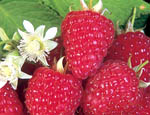What to do in the garden this week: July 8
This week the task of the moment is cutting out old raspberry canes


St Peter's Church at Terwick consists of nave and chancel no tower or spire outside, no decoration inside. Small and movingly simple, it certainly dates from the 12th century and is probably older still. Cradled by the South Downs and shaded by Methuselah yews, it is England in epitome. Before the 1930s, its nickname, The Church in the Field, was merely a nod to its isolation, but then the field in question changed. St Peter's acquired not one but hundreds of spires, all in brilliant colour. It became The Church in a Field of Lupins.
The land and the lupins were given to the National Trust in 1939 by Jane Patterson Hodge of Fyning House in memory of her husband, Thomas. Mrs Hodge was confident that the lupins would thrive in a meadow mown only once a year. She knew a bit about survival, having been a passenger on the Titanic. And thrive they did, becoming a famous sight-a sea of crimson, mauve, cobalt and gold on which St Peter's would miraculously float each summer.
But seven decades is a long time for lupins to contend with Nature, and the field had declined. Recently, the National Trust, together with volunteers from local villages and the mental health charity Mind, has been restoring Mrs Hodge's gift. Operation Lupin has been a runaway success, quietly upstaging the season's usual horticultural extravaganzas. The garden image of the year won't be the smartest design or latest plant introduction. It will be a field full of old-fashioned flowers by an ancient church, a gesture of love made by a courageous woman, now saved by well-wishers.
Mrs Hodge could not have picked a better moment to create her husband's memorial. Only two years before, Russell Lupins had become available, a hybrid race of sturdy perennials in previously unseen colours. They were raised by George Russell, a professional gardener who had been crossing Lupinus polyphyllus with other species on his allotments near York since 1911. It took 25 years to persuade the magnificently chauvinistic Russell (by then aged 78) to release his creations into the depravity that, he was sure, lay beyond Yorkshire's borders. They caused a sensation when Baker's Nursery near Wolverhampton began selling them in 1937.
The good people of Terwick could not have picked a better moment to restore their field. Lupins fell from grace during the 1970s, a decade of bad fashion decisions. In the mid 1980s, Woodfield Brothers near Stratford-upon-Avon, Warwickshire (01789 205618), bucked the trend with a new range of cultivars whose flower spikes were taller, more elegantly tapered and more tightly packed than the Russells, and in far richer tones.
However, it's only lately that their presence has truly been felt again in gardens, and to glorious effect. Nothing competes with them for vertical colour in an early summer herbaceous border. Meanwhile, Sarah Conibear at Westcountry Nurseries in Devon (01237 431111; www.westcountrylupins.co.uk) is adding spectacular new varieties to the palette-some in go-to-hell shades such as Manhattan Lights (two-tone, Silk Cut purple and Ferrari yellow), and others of marvellously cool refinement, such as Blossom (white, flushed with pale rose) and Persian Slipper (white buds opening to lavender blue). Both Woodfield Brothers and Westcountry Nurseries offer cultivars that extend the flowering season well into July and which require no staking.
Although herbaceous borders are the obvious homes for them, lupins will flourish in rough grass, as Mrs Hodge suspected and vast areas of prairie prove. There are a few caveats, but none that should deter. Beware slugs, aphids, and the fungal disease anthracnose, which can cause die-back and crown-rot, especially in warm, wet weather. Deadhead promptly. Don't overfeed: in Nature, lupins colonise poor soils, fixing their own nitrogen.
Sign up for the Country Life Newsletter
Exquisite houses, the beauty of Nature, and how to get the most from your life, straight to your inbox.
Their liking for barren sites gave rise to the name Lupinus. From the Latin for wolf, it reflects an old misperception that lupins must have devoured the land's goodness when, in fact, they were replenishing it. In Iceland, this talent has led to their being naturalised on expanses of volcanic ash. Between Terwick and Eyjafjallajökull, this really is the lupin's summer.
* For more In the Garden like this every week, subscribe and save
Country Life is unlike any other magazine: the only glossy weekly on the newsstand and the only magazine that has been guest-edited by HRH The King not once, but twice. It is a celebration of modern rural life and all its diverse joys and pleasures — that was first published in Queen Victoria's Diamond Jubilee year. Our eclectic mixture of witty and informative content — from the most up-to-date property news and commentary and a coveted glimpse inside some of the UK's best houses and gardens, to gardening, the arts and interior design, written by experts in their field — still cannot be found in print or online, anywhere else.
-
 Vertigo at Victoria Falls, a sunset surrounded by lions and swimming in the Nile: A journey from Cape Town to Cairo
Vertigo at Victoria Falls, a sunset surrounded by lions and swimming in the Nile: A journey from Cape Town to CairoWhy do we travel and who inspires us to do so? Chris Wallace went in search of answers on his own epic journey the length of Africa.
By Christopher Wallace
-
 A gorgeous Scottish cottage with contemporary interiors on the bonny banks of the River Tay
A gorgeous Scottish cottage with contemporary interiors on the bonny banks of the River TayCarnliath on the edge of Strathtay is a delightful family home set in sensational scenery.
By James Fisher